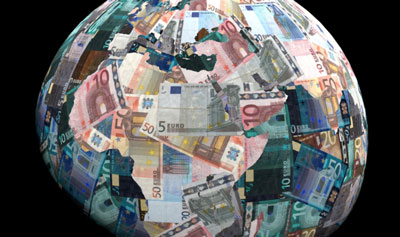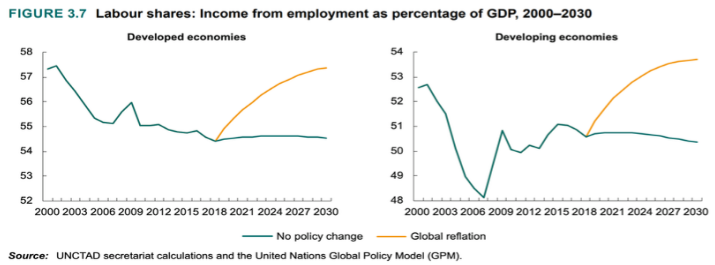Plans for a global Dystopia

Global policy planners intend to deliver replacements for both dollar hegemony and fossil fuels. Plans may appear uncoordinated and in their early stages, but these issues are becoming increasingly linked.
A monetary reset incorporating state-sponsored cryptocurrencies will enable exchange controls to be introduced between nations by separating cross-border trade payments from domestic money circulation. The purpose will be to gain greater control over money and to direct its investment into green projects.
The OECD will build on current tax disclosures to make everyone’s income and capital known to governments and therefore readily taxable, money destined to kick-start economic growth. Under the guidance of supranational organisations, governments will redirect investment into green technology. The objective, particularly for Europeans, is to neutralise Russia’s increasing dominance of the global energy market by becoming carbon neutral by 2030.
But perhaps as Robert Burns put it, “the best-laid schemes o’ mice an’ men gang aft agley”. They are based on Keynesian fallacies, but cannot be ignored.
Introduction
There appear to be policy areas being driven by statist responses to events, encouraging global institutions to take on a coordinating role. It means deeper levels of centralised planning by unaccountable bureaucrats. Assuming their plans continue to gain credence, we could end up with a dystopian world where supranational bodies direct individual governments to conform. We are already on this road to perdition. The OECD has coordinated attempts by governments to restrict the freedom of their citizens to avoid taxes by forcing over a hundred jurisdictions to automatically supply information on the financial affairs of every citizen, irrespective of nationality and where they reside.
By doing so, it has removed the necessity for governments to moderate their tax demands for fear that individuals will move their money out of reach. Information on private affairs are now exchanged automatically by banks, lawyers, financial advisors and accountants, without the individual’s knowledge. As a result of the introduction of the OECD’s common reporting standard, the organisation claims that over $85bn of additional tax revenue has been raised. The intention is to raise more, much more.
This has been the OECD’s mission for some time, leading the way for other supranational organisations to carve out roles for themselves. Ones that come to mind are the IMF, which with a green agenda intends to prioritise investment funding for alternatives to fossil fuels both directly and indirectly through the World Bank and the regional development banks. Subsidiary roles are likely to be played by other UN divisions, useful for binding emerging market nations to the plans.
Central banks acting in concert could have a new role of coordinating a monetary reset, which as we can deduce from Mark Carney’s speech at Jackson Hole in August is already being discussed. We shall start by looking at the state of current monetary policies, their failure, and the drive to replace them with something else, before addressing the energy question.
The monetary problem
There are two categories of folk who think everything to do with economics and money are not much to worry about; the disinterested public and the investment management community. Their livelihoods depend upon it. Another category, libertarians, Austrian economists, bitcoin fans, gold bugs and readers of and contributors to agglomerating sites such as ZeroHedge have views ranging from sceptical to downright catastrophic. Not known to many is another, the most important category, which is very worried indeed, and that is governments and their central banks.
These are the people quietly talking about a big-picture reset, those that know the post-Breton Woods fiat dollar system is no longer fit for purpose. They see escalating debt, interest rates failing to stimulate, and economic stagnation. They see a mismatch between international trade and the use of the dollar as a global settlement medium. They don’t talk about it much, to do so would frighten us, the lowly ruminants.
I was ruminating on this recently after Max Keiser, of the Keiser Report on RT, asked me what I thought of Mark Carney’s speech at Jackson Hole in August about a global monetary system to replace the dollar. I replied something about Carney about to retire, and presumably feeling slightly freer to express the concerns which he must share with his friends at the Bank for International Settlements, and various other monetary panjandrums who have observed the obvious: their cosy world of money-printing doesn’t work, is unlikely to ever work, and must be reformed to give them more control.
Since then my thoughts have turned to the reset problem in a broader sense. The assumption must be that time is available for such an event to be planned, or at least pre-planned as an insurance policy against monetary failure. In either event, it is putting the cart before the horse, because when a credit crisis hits it invariably takes the authorities by surprise, and it looks increasingly close in time. The priority will not then be monetary evolution but economic and financial rescue.
That point having been made, from the central bankers’ point of view, what is to be done? The obvious answer is to rig the game by changing the rules. As Keynes said, when the facts change, he changed. That way, they think they might dispose of the failing system and replace it with an updated one that suits their policy purposes better. With a bit of luck, declining confidence in the old will be replaced by a new paradigm, something that will allow them all, politicians and central bankers, to claim success for saving the Western world from a potential monetary crisis.
The problem is they don’t know how to do it, and they don’t yet know what the new paradigm will be. There is no unity on the matter, because for the Fed and the US Government it involves an unacceptable loss of monetary and political power. The Chinese, in partnership with the Russians, want to do away with the dollar, while the Europeans are leading themselves to a socialist dystopia at odds with Trump’s America, while being frightened of the Russian bear in the east.
This is why influencers like Carney can only hypothesize about a new monetary set-up involving a reduced role for the dollar. Central banks are exploring cryptocurrencies. It is reported that seven out of ten of them are researching the possibilities. That won’t save fiat currencies, but it might give central banks greater control over how their fiat currencies are used. Perhaps they think a state issued cryptocurrency can replace unadorned fiat. But then that raises two issues: if the existing fiat is failing it is likely a new state-sponsored cryptocurrency risks having a credibility problem from the outset and even if the public does accept it, its future issue will have to be strictly limited and the cycle of bank credit properly addressed.
But get it right and markets could be tamed, the logic goes. And somehow, a global cryptocurrency-based monetary system for international trade could replace the failing post-Bretton Woods monetary system reserved on the US dollar. For policy makers, it is becoming an urgent question, as a reading of Carney’s Jackson Hole speech makes clear.[i]
Specifically, in his speech Carney identified the existence of a global liquidity trap nullifying interest rate policy with three elements: a global savings glut tied up in dollars, a reduction in the scale of sustainable cross border flows and “fattening of the left-hand tail and increasing the downside skew of likely economic outcomes”.[ii] This last element of gobbledegook appears to translate into an acknowledgement of the failure of current interest rate policy to stimulate economic recovery, which cannot be admitted in plain English.
Carney’s problem, besides the veiled admission of policy failure, is he ignores the fact that America needs increasing quantities of foreign dollar ownership to fund its escalating budget deficit, without which the dollar fails, and term interest rates will soar. If he and his cohort push policies intended to redeploy funds that are otherwise destined for the dollar and US Treasuries, they will face strong opposition from the US Treasury and being based on the dollar, the likely collapse of the whole fiat edifice.
As for a reduction in cross border flows, that is a function of falling cross-border trade, not money. The reason cross-border trade has collapsed is because of the US-Chinese trade spat and its knock-on effects. Even if we pass on the gobbledegook of his third point, it is difficult for an independent observer not to take Carney’s speech as indicative of desperation, ivory-tower economic error or both.
Being based on Keynesian macroeconomic beliefs, we can take the evidence of economic error for granted, particularly since these beliefs have consistently failed to deliver any credible solution. It is the element of desperation we must explore further. If Carney feels a sense of desperation (and his speech reeks of it) then his fellow central bankers will as well. But instead of just abandoning failed policies, a bridge is required towards a new set of policies, a monetary reset. And it will almost certainly involve a greater suppression of the role of markets and an increase in state control over money and how it is used.
For central bankers, there is a fear that the emergence of a competing private sector crypto-payments system, even linked to a basket of fiat currencies, will challenge national currencies. They would have to be pretty dopey not to see that Bitcoin in particular is educating the masses about the moral fraud behind the expansion of fiat money. The challenge will be to come up with a credible alternative, completely under the control of a few major central banks. But first, the purpose of a state-backed cryptocurrency must be settled.
For every nation other than America, evolution from the failing post-Breton Woods monetary system is about reducing the role of the dollar in trade settlement and freeing up capital needlessly tied up in dollars. Before the invention of cryptocurrencies, this would presumably have been achieved through a combination of an evolutionary process and increasing use of currency swaps to enhance liquidity, particularly in euros and renminbi, to replace the dominance of dollars in reserve balances.
The facilitation of foreign trade appears to be the role most likely to be destined for a state-issued cryptocurrency. Initial swap lines of state-sponsored cryptocurrencies would be proportionate to the trade between existing currency blocks. It could then be deployed for trade settlement, which would require it to be made available to commercial banks. We then have two currency versions: an existing fiat currency which circulates domestically and a separate blockchain based currency reserved for international use. With an onshore and offshore version, there can be two interest rates suitably set for their applications, so long as arbitrage routes are severely restricted, with the offshore version trading at a premium.
Old hands in Britain will be familiar with the basic concept, before Margaret Thatcher removed exchange controls. To monetary planners, there are several perceived benefits from such a scheme, particularly for the Eurozone. By separating trade settlement from domestic currency circulation, de facto currency controls are introduced, permitting access to the state crypto currency to non-domestic trading entities and banks, while denying its use in the domestic economy. Importantly, the expansion of bank credit would be retained for the domestic currency only, managed through a two-tier interest rate policy.
Any investment in foreign currencies would require the payment of the premium that applies on the crypto version of the currency. The prospects of an international run against a currency such as the euro would recede, as the existing liquidity for international trade is replaced by a centralised, highly managed, trade-related cryptocurrency.
For policy makers at the ECB it must be a tempting solution if it can be made to work. It would give them greater monetary control overall, and they could attempt to stimulate the Eurozone economy by deploying deeper negative rates without the fear of a failing exchange rate.
From America’s point of view these moves or anything like them will almost certainly be strongly resisted. They need foreigners to buy dollars to fund the budget deficit. And they are now experiencing the flaws of US isolationism and Trumpian trade policies, which are already leading to a contraction and potential reversal of foreign flows into US Treasuries.
China would be an interested observer of these developments. She has been planning to issue a cryptocurrency of her own, which could allow her to internationalise a crypto version of the renminbi more rapidly than it has managed with its existing renminbi. Russia has already ditched the dollar for geopolitical reasons and is trying to gain control over the energy market from a moribund OPEC.
To summarise, discontent with the post Bretton Woods monetary system and the disproportionate role of the dollar are likely to be the reasons why so many central banks are looking at cryptocurrency solutions. But as stated at earlier in this article, it assumes pre-planning, those best-laid schemes of mice and men, are not overtaken by events.
Crypto and gold
There can be little doubt that monetary policy is descending towards crisis, and a major bank failure could even occur in the next few months. If we find ourselves facing another Lehman moment, the priority will be to stabilise markets first, and then currencies as needed at a time of widespread negative interest rates and bond yields.
As insurance against such an event, the majority of central banks retain physical gold as part of their reserves. In Europe, Germany France and Italy hold significant quantities of gold which the monetary authorities at the ECB might in theory wish to deploy as the backing for a common cryptocurrency. But this is unlikely to be a preferred option, because central banks always retain their gold reserves (leasing aside) and only use them for monetary purposes as a last resort.
To re-introduce gold backing would deny all credibility to neo-classical macroeconomic theory, which relies on achieving an inflation target consistent with maximising employment. Given the need for a rapid expansion of global money supply as a policy response to the next credit crisis or to finance escalating government debt, the purchasing power of state-issued currencies will almost certainly decline while that of gold will rise. A currency credibly linked to gold would therefore also rise, assuming it acts as a proper gold substitute. A gold standard fixed at the current rate of $1500 would be seen as strongly deflationary if gold goes any higher.
It is therefore probably true that no Western central bank would contemplate such a move in current economic conditions. If, in time, a credit and systemic crisis threatens the destruction of unbacked state currencies, and the event causes conventional thinking in the central banking community to discard inflationism, that would be a different matter. But that is far from the current situation.
In any event, a far higher gold price would be required to fix fiat currencies sustainably to gold. Even China, which has been accumulating physical gold and encouraging its people to do so as well, is too hooked on monetary and credit expansion as the principal means of driving its economy to contemplate such a move for its own economy. However, the accumulation of gold reserves by many of China’s Asian trading partners suggests some sort of gold backing for a cross-border settlement medium is likely instead of delivering physical gold, and this is where China’s plans for a new state-sponsored cryptocurrency may eventually be heading.
The conflict over energy
As is the case with the global monetary system, global energy markets face enormous change with both the EU and supranational organisations, such as UNCTAD, the UN’s conference on trade and development, pushing a policy of dropping carbon fuels for green alternatives. Furthermore, the original agreement whereby Saudi Arabia agreed to sell its oil for dollars, giving US banks control over monetary surpluses from all OPEC’s oil sales, is no longer appropriate because the energy world has radically changed since that deal was struck in 1973.
That agreement has been the central plank to the dollar’s role as a reserve currency. Since 1973, the Soviet Union has collapsed and under President Putin, Russia has emerged as the largest exporter of oil and gas combined. Furthermore, as America’s victories in the Middle East are proving to be only pyrrhic, Russia’s influence is spreading across the region, forming alliances with Iran, Turkey and Syria. China is the region’s most important energy customer, and with its silk road projects is also increasing its influence on the region.
America’s response to these developments is lacking focus. It now has precious little real business in the region other than arms supplies, and under President Trump America has become isolationist. Furthermore, Trump wished to disengage militarily from the region, while the intelligence and military establishment wanted to increase their commitments. The gaps in US policy have been quietly exploited by Russia and China to great effect.
The EU sees US leadership failing while the Russian beast to its east are getting stronger. The lessons of Russia wielding power over Ukraine by cutting off energy supplies have been noted: energy security is a long-term threat to the EU and Russia is on the verge of controlling Middle Eastern supplies as well. Furthermore, the lessons of China’s economic successes through non-democratic government control will also have been noted as something for European statists to emulate.
The EU’s response to the energy threat from Russia has been to adopt a radical green agenda without reservation. Despite about 98% of transport and logistics being delivered by diesel and gasoline, some member states in the EU are banning the sales of internal combustion engines as motive power from as soon as 2030. This accelerated path to zero emissions will require massive investment. Clearly this is being viewed as economically stimulative at a time of declining optimism over the general economic outlook.
These views are articulated in UNCTAD’s Trade and Development Report 2019, Financing a Global Green Deal[iii]. The authors argue that internationally coordinated action between governments pursuing reflationary monetary and fiscal policies, while restricting international capital flows, will generate the economic growth and capture the resources to finance the investment. The charts below are indicative of their thinking, and are copied from Page 56 of the report.

This is one of several examples in the report. Here, it is argued that a combination of higher minimum wages and increasingly progressive rates of taxation to redistribute wealth to lower earners leads to greater economic growth, in this case by boosting consumption of the masses at the expense of the few. It’s pure Keynesianism.
Similar arguments are made for increasing government spending on goods and services and increasing spending on welfare to further boost consumption. More extensive use of capital controls to restrict destabilising investment flows and to make them available for green investment instead are recommended (pp. 125-129). Central banks are encouraged to direct quantitative easing in favour of green investment, and through regulation impose higher risk margins on bank exposure to fossil fuel related investments and loans (pp. 153-156).
It amounts to an extension and escalation of failed inflationist policies, but the underlying point is it transfers free markets to statist management on a global scale not seen before. The ambition is for a few supranational organisations, not accountable to anybody, to act as an informal world government. It also accords fully with how central banks are likely to restructure their currencies
Welcome to Dystopia.
Conclusion
Failing monetary policies and the accelerated disposal of carbon-based in favour of carbon-neutral energy provide the foundations for a dystopian future. Together, they are excuses for yet greater inflationism and the rapid socialisation of national economies and private capital.
Clearly, a number of supranational bodies expect to coordinate these policy areas above the heads of individual governments. A monetary reset will replace a failing dollar-based system, and failing economies will be boosted by state-directed green investment.
Given that a significant cyclical credit and systemic crisis is overdue, its occurrence will have a major effect on how matters actually proceed. People who value individual freedom and privacy, those horrified by Orwell’s Nineteen Eighty-Four and Hayek’s The Road to Serfdom, could find themselves wishing for an even more radical outcome: the complete destruction of the fiat currency system and of the whole statist command-and-control apparatus.
[ii] Ibid. Page 4
[iii] https://unctad.org/en/PublicationsLibrary/tdr2019_en.pdf
By Alasdair Macleod, www.goldmoney.com
Find more: Contributing Authors






























